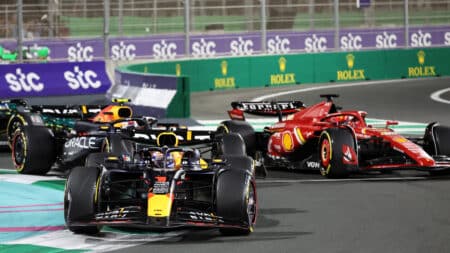
Which Red Bull will show up in Jeddah? - What to watch for at Saudi GP
Can Red Bull rebound from its poor Bahrain showing? And will it be Piastri or Norris leading McLaren's charge? Here's the five themes to watch for at the Saudi Arabian GP
We’re having a great F1 season, but it could be an even better one.
While the fight at the front of the field has at least involved more than one team for the last couple of seasons, the intense battle behind the big three this year has been fascinating. There’s a chasm between Ferrari/Mercedes/Red Bull and the rest – quite often 1sec or more. But the order between Haas, Renault, Force India – with occasional interruptions from Toro Rosso, McLaren and Sauber – has been highly volatile from one track to the next.
In the 13 races to date, seven drivers from five teams have ‘won’ the unofficial category of best of the rest and each of the first six races saw a different ‘winner’. Both drivers of Haas, Renault and Force India have been on class pole, but just the slightest stumble can leave one or more of their cars mired in Q1 courtesy of Toro Rosso, McLaren or Sauber.
Ignore the top three teams and imagine this was the battle for overall wins and title, and we have seen:
The budget cap of 2021 will bring this sort of intensity and volatility to the front of the field, right?
Haas dominating the opening round with their cars running 1-2 until their disastrous pitstops, which should have given the win to Hülkenberg’s Renault. Except he’d just pitted before the safety car and so was leapfrogged to victory by Alonso’s McLaren.
A dominant performance from pole to victory for Pierre Gasly’s Toro Rosso-Honda in Bahrain, followed by a similarly dominant performance from Hülkenberg’s Renault in China.
Sergio Pérez keeping his Force India out of reach of an intra-team Renault fight at Baku, with Sainz being chased hard by Hülkenberg until the latter crashed out. This promoted Charles Leclerc’s Sauber up to third, who impressed by taking his first podium.
In Spain, a great pressure drive from Kevin Magnussen, under attack from Sainz’s Renault, to give Haas its first Grand Prix win.
A perfect lights-to-flag victory at Monaco for Ocon’s Force India, with Hülkenberg doing pretty much the same two weeks later in Montréal, heading a Renault 1-2.
In France, Sainz suffered the heartbreak of losing Renault ERS-k power two laps from home, having dominated from the start. He limped to third and handed victory to Magnussen.
Having endured a difficult season to date, Romain Grosjean suddenly rediscovered the form of his Lotus years to dominate the whole Austrian weekend, giving Haas its third victory of the year.
At Silverstone, Magnussen put the Haas on pole but was beaten into the first corner by Hülkenberg’s Renault. Magnussen ran second early on but was then passed by Leclerc, with the flying Sauber then putting real pressure upon leader Hülkenberg. Sauber tried for the undercut on the Renault but just as the world waited with baited breath to see if the rookie could win in just his 10th race, he was released with a loose wheel and had to retire, letting Hülkenberg off the hook.
Magnussen again set pole in Germany and this time led for much of the distance. But under pressure from the closely-following Hülkenberg and Grosjean, he ran out of rear tyre grip and ran wide – allowing them to pass, with Hulk taking his second consecutive win. Remarkably, it’s the first time all season anyone has won consecutive races.
In Hungary, Sainz and Gasly were in a class of their own in wet qualifying but it was the Toro Rosso ahead into the first corner – and from there Gasly was on his way to his second win of the season.
Esteban Ocon beat team-mate Pérez to pole by hundredths at Spa, but Sergio turned the tables in the race to give Force India its second 1-2 of the season.
Sounds good, doesn’t it? Sounds better than a two-team slog with number one and two drivers.
So what makes this second division so much more closely-contested than the ‘premiership’? They can all reach a similar budget level whereas the Ferrari, Mercedes, Red Bull money is way beyond their reach. So the big three have more people, better facilities, more programmes, more R&D etc.
So, the budget cap of 2021 will bring this sort of intensity and volatility to the front of the field, right?
No, Mercedes and Ferrari are busy ensuring that the cost cap is kicked into the long grass for a further two years (and ensuring that the engine regulations remain essentially unchanged too).
What possible motivation could there be for the two dominant teams to ensure things remain just as they are? Hmm…
The tail is wagging the dog and the FIA is not standing firm in curbing the power of the top teams. If it doesn’t do this, Liberty cannot do anything other than work around the wishes of Mercedes and Ferrari.

Can Red Bull rebound from its poor Bahrain showing? And will it be Piastri or Norris leading McLaren's charge? Here's the five themes to watch for at the Saudi Arabian GP

McLaren's breakthrough in a near-four-year-old ruleset shows F1 rules convergence is a myth – just like Sebastian Vettel, Red Bull and Renault did in 2013, writes Mark Hughes

Madrid finally has a consortium to build the new Formula 1 circuit that will host the 2026 Spanish GP

Helmut Marko caused a stir after the Bahrain GP with his worries that Max Verstappen could leave Red Bull early. But how real are those fears?